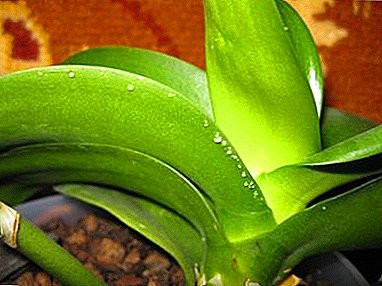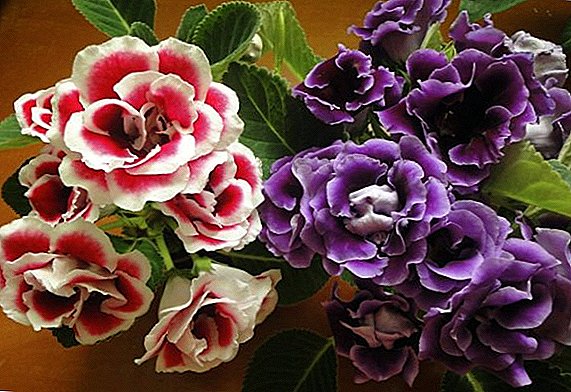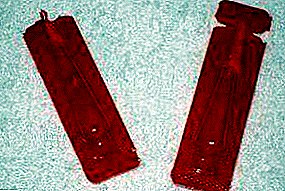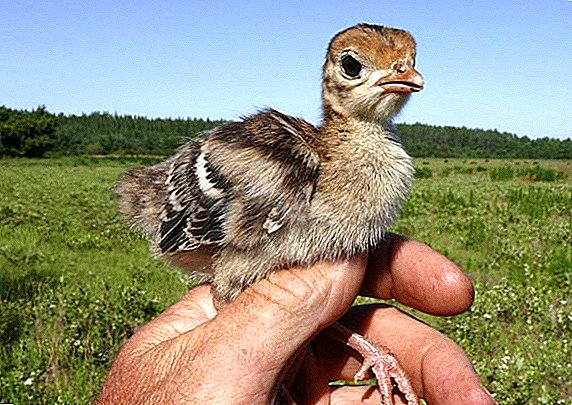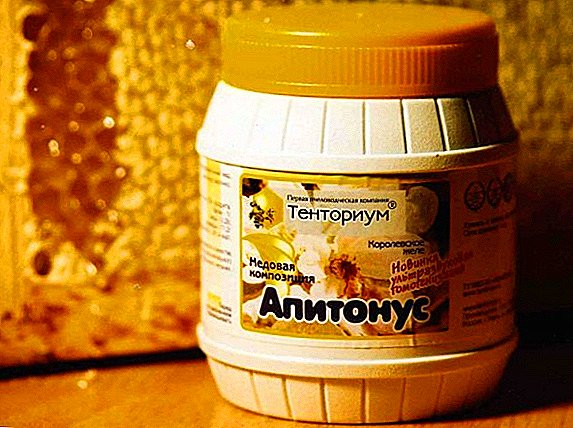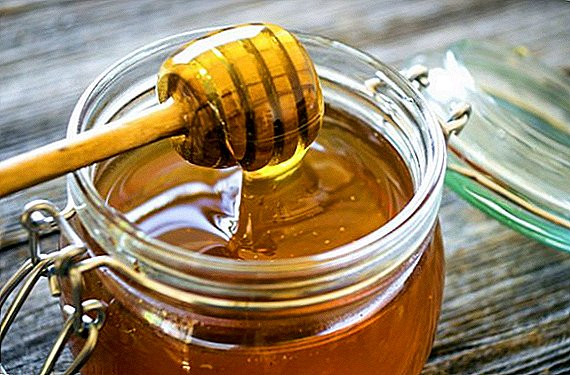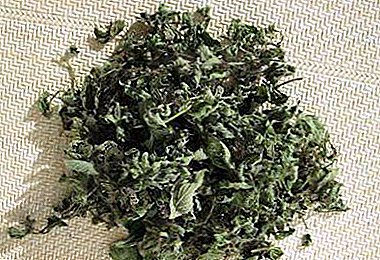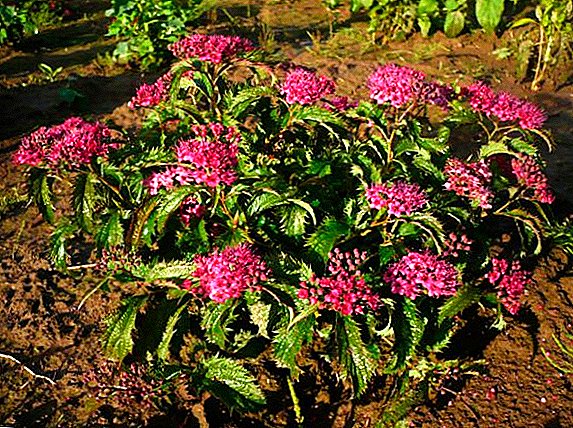 A beautiful bush, exotic inflorescence and unpretentiousness in the care made Japanese spirea a favorite among landscape designers and ordinary gardeners. It is easy to work with it even for beginners, the requirements for soil and moisture are minimal, but the result pleases the eye. Today we will learn more about this ornamental shrub, learn to grow it on the site and reveal the secrets of long flowering.
A beautiful bush, exotic inflorescence and unpretentiousness in the care made Japanese spirea a favorite among landscape designers and ordinary gardeners. It is easy to work with it even for beginners, the requirements for soil and moisture are minimal, but the result pleases the eye. Today we will learn more about this ornamental shrub, learn to grow it on the site and reveal the secrets of long flowering.
Botanical description
The Japanese genus of spirea belongs to the Pink family and consists of more than 100 species of various shapes and colors. Depending on the variety, the flowering period of this deciduous shrub also differs. 
You can learn spirea by:
- high bush that reaches from 0.5 to 2.5 m;
- bent up branches dotted with medium-sized decorative leaves of green tones;
- small flowers that grow in large groups, delighting the look with all shades, from white to dark pink;
- subtle unobtrusive aroma.
Did you know? In Eastern Europe, spirea is also known as tavolga.The shrub does not grow very quickly, lives on average 15-20 years, after which it is desirable to replace the plantation.
Distribution and habitat
Homeland plants, as the name implies, is Japan, as well as neighboring China. Under natural conditions, spirea occurs in the chernozem belt of Europe, the deciduous forests of Siberia. This shrub loves gentle mountain slopes, open forest glades, sometimes it can be seen on almost bare rocks. Also, meadowsweet often thrives on the marshy river banks, at the edge of the lakes.
Check out the varieties and varieties of spirea.
Common varieties
Nature and breeders have taken care of a wide variety of varieties of spirea, among which the most popular were:
- "Golden Princess". An attractive plant rarely reaches 1 m in height, but literally captivates the gaze with golden leaves with sharp tips that play with different shades throughout the year. In mid-June, they are complemented by fragrant inflorescences of pale pink, pleasing decorators until autumn.

- "Little Princesses". This species is distinguished by its spherical crown and compact size (up to 30 cm tall). Such features made the "Little Princess" an ideal shrub for alpine slides, compact flower beds, wide curbs. The miniature plant and flowers are small: they dot its branches with bright pink petals, gathered in brushes up to 5 cm in diameter.

- "Shirobana". Distinctive features of this variety are the stems in the form of thin brown-maroon rods, a scattering of dark green small leaves, which closer to the autumn are colored in yellow, red colors. But the fame of "Shiroban" acquired due to its flowering, when white, pink and red inflorescences appear simultaneously on its branches.

- "Spirea Macrofile". Frost representative of the genus that grows to 1.5 m and has large wrinkled leaves up to 20 cm in length. The young growth of this species is painted in dark red, maroon colors, by the summer it turns green, and closer to the autumn it is colored in golden tones. It blooms from June to August, becoming covered with short pink flowers during this period.

Did you know? Spirea is translated from the Greek as "spiral, bend."
- "Crisp". Graceful undersized plant with elongated leaves that form a spherical cap of a dark green shade. I am pleased with the color of the variety from mid-summer to September, being covered with pale pink with purple tint in bulk. Its flowers are collected in umbellate inflorescences of no more than 5-7 cm. They are distinguished by "Crispus" and upright shoots, in rare cases bending at the ends.

- Goldflame. The variety belongs to the best representatives of its kind, possessing a small but dense crown, up to 80 cm high, and a beautiful color of all shades of yellow. He has direct shoots, dotted with small flowers that appear in June-August, for which the decorators like to use Goldflame in urban environments.

- "Darts". Another compact shrub with leafy leaves of the original coloring: when blooming, they are reddish, becoming light green closer to the middle of summer. Flowers are collected in large inflorescences of pink, red, burgundy flowers that appear on the tops of shoots from June to early autumn. Sometimes "Darts" pleases with repeated flowering, though not so abundant.

Use in landscape design
Japanese designers especially like Spirea for the opportunity to provide flowering in the garden throughout the season thanks to the varied varieties that bloom alternately. To do this, they are combined in groups, used in rocky gardens and as green surfaces. High varieties also perform well in the role of borders and hedges. Thuy, spruce, juniper will work well in the company for spirea.
Learn also about the cultivation of spiraea "Bomald", "Vangutta", "Grefsheym", "Snowmaund", as well as spiraea birch and white.
Growing and caring for plants
To enjoy the beauty of Spirea, it is important to organize the planting and further care for the plant.
Conditions of detention
The plant loves the open ground, but you need to have time to plant it in the spring until the buds begin to blossom. It is best suited for this rainy or overcast evening. For better development, spirea needs more light, although in the partial shade it feels good. 
Important! When planning a future garden or rock ariel, keep in mind that as the shrub grows, it will require a significant area for its root growth.
Soil and fertilizer
Spirea is able to grow in poor soils, but in this case it will not be able to demonstrate all its beauty. Optimal for it are loose, air-tight soils, filled with humus. The acidity of the soil will be at the level of 5.6-7.8 pH. It is important to make a 15-20 cm drainage layer during planting, brick crumb will do for this. As a primary feed take the leafy soil or turf, sand, peat in a ratio of 2: 1: 1.
Choose the best flowering shrubs for the garden.
Further, as it grows, it is desirable to apply:
- complex feeding after trimming the bush;
- solution of mullein with superphosphate (10 grams per 10 liters of liquid) closer to July.
Watering and moisture
The first watering is carried out even when planting a bush: 1-2 buckets of water at a time. Because of the underdeveloped root system, it is undesirable to experience drought with spirea, therefore, in hot weather, proper watering is important: 15 liters of water twice a month for 1 bush. During the period of moderate temperatures, it is not worth watering the plant actively. But weeding and loosening regularly spend to ensure a constant access of oxygen to weak roots. 
Relation to temperature
That heat, that the cold spiraea endures without difficulties, because in natural conditions it grows in rather harsh conditions.
Important! But if there is a threat of severe frosts in the absence of snow, then play it safe and cover the rosette of the plant with a 10-15 cm layer of leaves.
Plant reproduction and planting
Spirey can be propagated in three ways:
- seeds;
- layering;
- cuttings.
Growing from seed
Immediately make a reservation that this method is not suitable for hybrid varieties due to genetic features. Reproduction of spirea seeds is as follows:
Reproduction of spirea seeds is as follows:- Take the seed.
- Prepare wide containers with low walls.
- Fill them with a mixture of peat and hardwood.
- We spread the seeds on the workpiece and cover the top with 1 cm of peat or sprinkle with earth.
- After a week and a half we expect the appearance of the first shoots.
- They must be taken care of and treated with phytosporin, foundation, or any other anti-fungal drug.
- 2-3 months after germination, the seedlings are ready for planting in open ground in light partial shade.
- Be sure to pinch the small roots.
- Planted shoots we water and mulch with peat.
Landscape design at the summer cottage with their own hands - create beauty.
Reproduction by layering
Apply this method is spring. Low located shoots are pressed to the ground in the previously made notches and fasten so that the branch does not return to its original position. The tip of the future seedling is cut and sprinkled over the entire length of it with earth. For the winter, don't forget to hide the layers under a warming blanket of leaves. Already by the first spring the shoot will take root and it can be planted at the right place.  The principle of reproduction of bush bushings /
The principle of reproduction of bush bushings /
Did you know? Spirea gave humanity the opportunity to invent one of the most popular medicines in the world - aspirin. It is all about the glycoside salicin, a component in the composition of the stems of the plant, which as a result of long chemical experiments turned into a drug.
Growing from cuttings
The method is quite simple in its technology and very effective, since up to 70% of shoots take root. It also allows you to work this way with hybrids. Ready for a similar procedure annual shoots, starting in mid-June, after they finish the phase of active growth and before the flowering period. Breeding pattern is as follows:
- Cut off the shoot so that it has 5-6 leaves.
- Bottom pair will need to be removed with petioles, and cut off the remaining leaves by half of the leaf.
- Dip the cuttings for 5-6 hours into a solution of epine (1 ml per 2 liters of water).
- Remove them from the liquid and sprinkle the end of the cutting with a growth stimulator.
- Plant the seedlings in containers filled with wet sand, diluted with peat, keeping an angle of 30-45 °.
- We cover the shoots with a film and put in a shady place for a couple of days, occasionally spraying them with water.
- Before the first frosts, it is necessary to plant the shoots in open ground, to tap well with leaves, and to put an inverted box on top, so that the future spirea will wait for spring. If during the transplant you move the roots with a lump of earth, then do not forget to water the seedling well after.
- The following year, full-fledged shoots will be ready and they can be planted in a permanent place.

Important! Spirea does not like not only drying, but also transfusion. For this reason, when landing, try to avoid groundwater in the immediate vicinity of the root system.
Pruning
One of the main conditions of flowering and healthy spirea is timely correct pruning, which provides a beautiful shape to the plant. Make it easy by the following rules:
- the best time for pruning is the beginning of spring;
- completely remove weak or dead sprouts;
- developed pagons are shortened to the nearest kidney;
- a plant aged from 4 years on average loses 20-25 cm during pruning;
- The 7-year-old bush is subject to total renewal, so we remove all the old shoots, leaving almost a stump;
- after the procedure it is necessary to feed the spiraeus to give it strength.
 Japanese spirea - pruning.
Japanese spirea - pruning.If an adult bush doesn’t return its green mass to the stump state during the season, then it’s time to change it to a new seedling.
Possible difficulties in growing
From the nuances of Japanese Spiraea care it is worth to highlight a few points:
- Do not forget to cover young plants for the winter to preserve their strength;
- also fresh seedlings need regular weeding so that weeds do not crush them;
- To preserve soil moisture before the dry months, mulching with sawdust can be done, 6-8 cm husk;
- if you do not plan to propagate the plant with seeds, then remove the dry flowers after withering so that the spirea will not lose in vain.
Did you know? Spirea, under its second name, "Tavolga" is often found in the popular Russian epic, for example, in the epic "Sadko".
Pests, diseases and prevention
Spirea is characterized by good health, it is rarely exposed to disease. Among its main enemies:
- aphid;
- spider mite;
- gray mold and any kind of spotting.
 Spider mite Even a dead spirea does not lose its colorful appearance, but you should not run the problem, so let's see how to deal with pests correctly:
Spider mite Even a dead spirea does not lose its colorful appearance, but you should not run the problem, so let's see how to deal with pests correctly:- spider mites can be identified by whitish paniculate spots, after the appearance of which the leaves turn yellow for a short time, and then dry and fall. Increased probability of occurrence of this pest occurs in July and August. 0.2% solution of arex, matefos, phosphamide will help to get rid of it;
- in the same period there is a threat of aphids that feed on the sap of the plant, leading to its death through drying. Against it, they use solutions of kronefos, fosalos, pyrimor;
- against fungal infections such as gray mold, blemishes come with fungicidal agents, Bordeaux mixture, colloidal sulfur.
Japanese spirea - the best varieties.
Japanese Spirea deserves the attention of gardeners and decorators for its beautiful appearance due to its raznazy shrub and small picturesque flowers. The plant will be a great addition to the alpine slide, curb or hedge. And given the simplicity and simplicity in the care, working with it will not cause unnecessary trouble or waste.









